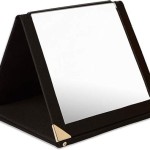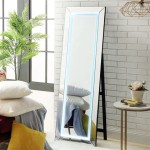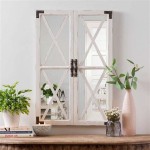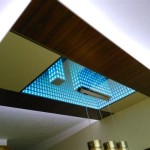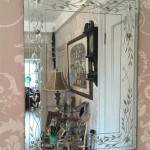How Do You Chalk Paint A Gold Mirror Frame?
Chalk paint offers a versatile and accessible method for updating furniture and décor, including gold mirror frames. Its matte finish and ease of application make it a popular choice for achieving a vintage or shabby-chic aesthetic. This article details the process of transforming a gold mirror frame using chalk paint.
Preparation is Key: Before beginning the painting process, proper preparation is crucial for achieving a smooth and durable finish. The first step involves cleaning the frame thoroughly. A mild detergent mixed with warm water is recommended for removing dust, dirt, and any oily residue. A soft cloth or sponge should be used to avoid scratching the gold surface. After washing, the frame should be rinsed with clean water and dried completely.
Protecting the Mirror: Preventing paint from getting onto the mirror surface is essential. Masking tape provides an effective barrier. Carefully apply the tape along the edge where the frame meets the mirror, ensuring a tight seal to prevent paint seepage. Wider masking tape offers better protection against accidental overpainting.
Priming (Optional but Recommended): While chalk paint is known for its adhesion, applying a primer, especially to smoother surfaces like gold leaf or metallic finishes, can improve the paint's durability and longevity. Primer creates a better surface for the paint to grip, minimizing the risk of chipping or peeling in the future. A primer specifically designed for slick surfaces is recommended. Allow the primer to dry completely according to the manufacturer's instructions before proceeding.
Applying the Chalk Paint: Chalk paint can be applied with a brush or a foam roller. A high-quality brush specifically designed for chalk paint is recommended for optimal results. These brushes typically have natural bristles that hold the paint well and provide a smoother finish. Apply the paint in thin, even coats, working in the direction of the wood grain if the frame is made of wood. Multiple thin coats are preferable to one thick coat, as thicker coats are prone to cracking.
Drying Time: Allow each coat of chalk paint to dry completely before applying the next. Drying times vary depending on the brand of paint and the environment's temperature and humidity. Refer to the manufacturer's instructions for specific drying times. Avoid rushing the drying process, as this can negatively impact the final finish.
Distressing (Optional): One of the appealing characteristics of chalk paint is the ability to create a distressed or aged look. This can be achieved using fine-grit sandpaper or a sanding block. Lightly sand the edges and raised areas of the frame to reveal the underlying gold finish or primer, creating a vintage effect. The amount of distressing is a matter of personal preference.
Sealing the Paint: Sealing the chalk paint is essential for protecting the finish and enhancing its durability. Two common sealant options are wax and lacquer. Wax provides a soft, matte finish, while lacquer offers a more durable, slightly glossier finish. Apply the sealant according to the manufacturer's instructions, ensuring even coverage. Multiple thin coats of sealant are typically recommended.
Removing the Masking Tape: Once the sealant is completely dry, carefully remove the masking tape. For best results, remove the tape before the sealant fully cures, as this can prevent the sealant from pulling away from the frame. Pull the tape slowly and at a 45-degree angle to avoid damaging the newly painted surface.
Clean-up: Clean your brushes and other painting tools immediately after use according to the paint manufacturer's instructions. Proper cleaning ensures that your brushes remain in good condition for future projects.
Variations and Techniques: Chalk paint offers a variety of creative possibilities. Experiment with different colors and distressing techniques to achieve unique looks. Layering different colors and then sanding through the top layer can create a multi-dimensional, aged appearance. Adding decorative elements, such as stencils or decoupage, can further personalize the frame.
Maintaining the Finish: Once the chalk-painted mirror frame is complete, proper maintenance will help preserve its beauty. Dust regularly with a soft, dry cloth. Avoid using harsh cleaning chemicals, as these can damage the painted surface. If necessary, clean the frame with a damp cloth and mild soap, then dry immediately. Reapplying a coat of wax or lacquer periodically can help maintain the finish's durability.
Transforming a gold mirror frame with chalk paint is a relatively straightforward process that can dramatically enhance its aesthetic appeal. By following these steps and taking the time for careful preparation and application, one can achieve a beautiful and long-lasting finish.

How To Paint A Mirror Frame Gold Remodelando La Casa

Chalk Paint And Antiquing A Frame Mirror Diy Painting Frames

How To Paint Gold Mirror Frame Keeping The Ornate Features Vickymyerscreations

How Do You Distress A Gold Mirror Frame Hometalk

How To Paint A Mirror Frame Gold Remodelando La Casa

How To Update A Gold Mirror With Chalk Paint Zucchini Sisters

How To Paint Gold Mirror Frame Keeping The Ornate Features Vickymyerscreations

How To Update A Gold Mirror With Chalk Paint Zucchini Sisters

Chalk Painting An Antique Mirror Frame Tutorial Rise And Renovate

How To Paint A Mirror Frame Gold Remodelando La Casa

